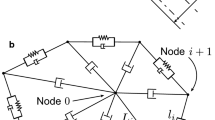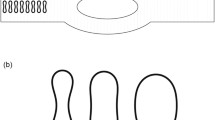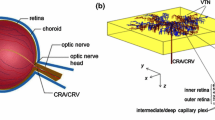Abstract
O2-delivery by a single capillary is a function of the flow rate and thefraction of flow made up of red blood cells. Capillary flow rate in turn depends upon flow resistance which is determined by thefraction of capillary volume occupied by red blood cells. Experiments were carried out to study the relationship between these parameters in an in vitro model consisting of glass capillaries (I.D. 3.3–11.0 μm) branching from a large bore feeding channel which was perfused at variable flow rates with suspensions of human red cells with different hematocrits. Capillary flow rates ranged from 0–10−4 mm3 s−1. The results indicate that the red cell flow fraction increases with increasing capillary flow rate and with decreasing feeding vessel flow rate. Capillary volume fraction occupied by red cells similarly depends on these two parameters, but is consistently lower than the red cell flow fraction. Capillary flow resistance increases with flow rate due to increasing volume fraction of cells. If the results obtained with the model system are applicable to in vivo capillaries it must be concluded that O2-delivery by a single capillary is not linearly related to flow rate but increases more than proportionately with flow rate. Due to alteration of resistance with flow rate another type of “autoregulation” of capillary flow is proposed which tends to keep flow rate constant despite changes of driving pressure.
Similar content being viewed by others
References
Albrecht, K. H., Gaehtgens, P., Pries, A., Heuser, M.: The Fahraeus effect in narrow capillaries (I.D. 3.3–11.0 μm). Microvasc. Res. (in press)
Bugliarello, G., Hsiao, G. C. C.: Phase separation in suspensions flowing through bifurcations: a simplified hemodynamic model. Science143, 469–471 (1964)
Bloch, E. H.: A quantitative study of the hemodynamics in the living microvascular system. Amer. J. Anat.110, 125–145 (1962)
Cokelet, G. R.: Macroscopic rheology and tube flow of human blood. In: Microcirculation. Vol. 1, (J. Grayson and W. Zingg, eds.), pp. 9–31. New York: Plenum Publ. Comp. 1976
Copley, A. L., Staple, P. H.: Haemorheological studies on the plasmatic zone in the microcirculation of the cheek pouch of chinese and syrian hamsters. Biorheology1, 3–14 (1962)
Dow, P., Hahn, R. F., Hamilton, W. F.: The simultaneous transport of T-1824 and radioactive red cells through the heart and lungs. Amer. J. Physiol.147, 493–499 (1946)
Fahraeus, R.: Die Strömungsverhältnisse und die Verteilung der Blutzellen im Gefäßsystem. Klin. Wschr.7, 100–106 (1928)
Gaehtgens, P., Benner, K. U., Schickendantz, S., Albrecht, K. H.: Method for simultaneous determination of red cell and plasma flow velocity in vitro and in vivo. Pflügers Arch. ges. Physiol.361, 191–195 (1976)
Gaehtgens, P., Albrecht, K. H., Kreutz, F.: Capillary hematocrit as a function of screening and Fahraeus effect. Amer. Inst. of Chem. Engineers, Symposium Series, New York no. 182, vol. 74, pp. 61–64 (1978)
Gelin, L. E.: A method for studies of aggregation of blood cells, erythrostasis and plasma skimming in branching capillary tubes. Biorheology1, 119–127 (1963)
Gelin, L. E.: A method for studying the aggregation of blood cells, erythrostasis and plasma skimming in branching capillary tubes. Bibl. anat. (Karger)4, 362–375 (1964)
Gibson, J. G., Seligman, A. M., Peacock, W. C., Aub, J. C., Fine, E., Evans, R. D.: The distribution of red cells and plasma in large and minute vessels of the normal dog, determined by radioactive isotopes of iron and iodine. J. clin. Invest.25, 849–857 (1946)
Goldsmith, H. L.: Microscopic flow properties of red cells. Fed. Proc.26, 1813–1820 (1967)
Hellberg, K., Rickart, A., Wayland, H., Bing, R. J.: The coronary microcirculation in the potassium chloride arrested heart. J. molec. cell. Cardiol.2, 221–230 (1971)
Jodal, M., Lundgren, O.: Plasma skimming in the intestinal tract. Acta physiol. scand.80, 50–60 (1970)
Johnson, P. C.: Red cell separation in the mesenteric capillary network. Amer. J. Physiol.221, 99–104 (1971)
Johnson, P. C., Blaschke, J., Burton, K. S., Dial, J. H.: Influence of flow variations on capillary hematocrit in mesentery. Amer. J. Physiol.221, 105–112 (1971)
King, T. K. C., Mazal, D.: Alveolar-capillary CO2- and O2-gradients due to uneven hematocrits. J. appl. Physiol.40, 673–678 (1976)
Klitzman, B., Duling, B. R.: Acute hematocirt changes in capillaries of striated muscle during functional hyperemia (Abstract) Microvasc. Res.15, 267 (1978)
Krogh, A.: The anatomy and physiology of capillaries. New Haven: Yale University Press, 1929
Lawson, H. C.: The volume of blood — a critical examination of methods for its measurement. In: Handbook of Physiology, Section 2: Circulation, Vol. 1, American Physiological Society, Washington, D. G., pp. 23–62 (1962)
Lipowsky, H. H.: In vivo studies of the rheology of blood in the microcirculation. Ph.D. Thesis, University of California, San Diego, 1975
Palmer, A. A.: Influence of absolute flow rate and rouleaux formation on plasma skimming in vitro. Amer. J. Physiol.217, 1339–1345 (1969)
Rapaport, E., Kuida, H., Haynes, F. W., Dexter, L.: Pulmonary red cell and plasma volumes and pulmonary hematocrit in the normal dog. Amer. J. Physiol.185, 127–132 (1956)
Schmid-Schönbein, G. W., Zweifach, B. W.: RBC-velocity profiles in arterioles and venules of the rabbit omentum. Microvasc. Res.10, 153–164 (1975)
Staub, N. C.: Microcirculation of the lung utilizing very rapid freezing. Angiology12, 469–472 (1961)
Svanes, K., Zweifach, B. W.: Variations in small blood vessel hematocrit produced in hypothermic rats by micro-occlusion. Microvasc. Res.1, 210–220 (1968)
Wayland, H.: Rheology and the microcirculation. Gastroenterology52, 342–355 (1967)
Wayland, H., Johnson, P. C.: Erythrocyte velocity measurement in microvessels by a two-slit photometric method. J. appl. Physiol.22, 333–337 (1967)
Yen, R. T., Fung, Y. C.: Inversion of Fahraeus effect and the effect of mainstream flow on capillary hematocrit. J. appl. Physiol.42, 578–586 (1977)
Yen, R. T., Fung, Y. C.: Effect of velocity distribution on red cell distribution in capillary blood vessels. Amer. J. Physiol.235, H251-H257 (1978)
Author information
Authors and Affiliations
Additional information
Supported by the Deutsche Forschungsgemeinschaft
Rights and permissions
About this article
Cite this article
Gaehtgens, P., Pries, A. & Albrecht, K.H. Model experiments on the effect of bifurcations on capillary blood flow and oxygen transport. Pflugers Arch. 380, 115–120 (1979). https://doi.org/10.1007/BF00582145
Received:
Issue Date:
DOI: https://doi.org/10.1007/BF00582145




